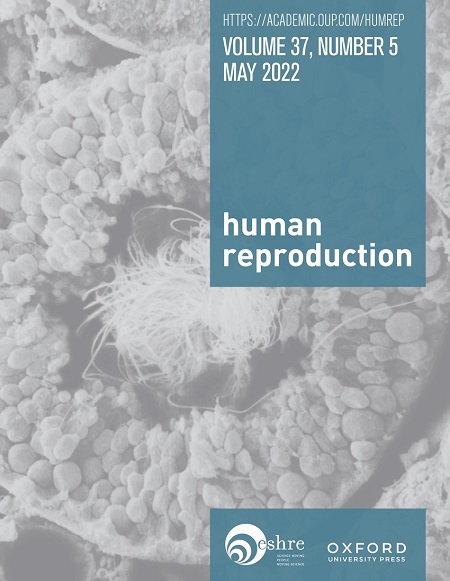Impact of definitive uterine artery occlusion on ovarian reserve markers in laparoscopic myomectomy: a randomized controlled trial with 2-year follow-up.
IF 6
1区 医学
Q1 OBSTETRICS & GYNECOLOGY
引用次数: 0
Abstract
STUDY QUESTION Does definitive occlusion of uterine arteries have a short- or long-term impact on ovarian reserve markers in reproductive-age women undergoing laparoscopic myomectomy? SUMMARY ANSWER Preventive definitive uterine artery occlusion (UAO) during laparoscopic myomectomy reduces intraoperative blood loss but does not impact serum AMH levels after short- and long-term follow-up in reproductive-age women. WHAT IS KNOWN ALREADY Uterine leiomyomas are the most common benign tumours in women of reproductive age. For symptomatic women willing to retain their uterus, especially for a future pregnancy, the current gold standard is surgical myomectomy for subserous/intramural leiomyoma. Temporary or definitive occlusion of uterine arteries can be performed to control bleeding during surgery but its impact on ovarian reserve markers is still unclear. A single randomized trial with a 1-year follow-up demonstrated that temporary bilateral UAO during laparoscopic myomectomy slightly decreased AMH levels at postoperative day 2 but has no significant impact at 3, 6, and 12 months after surgery. STUDY DESIGN, SIZE, DURATION We conducted a randomized controlled trial with a 2-year follow-up evaluating the effect of definitive occlusion of uterine arteries on ovarian reserve markers via sequential measures of AMH levels and AFC by ultrasound assessment. The study included 58 women with symptomatic leiomyoma type FIGO 3 to 6 scheduled for laparoscopic myomectomy between July 2015 and October 2021. Patient allocation was disclosed to the surgeon just before starting the procedure; women were blinded to group allocation throughout the study. PARTICIPANTS/MATERIALS, SETTING, METHODS Patients were randomized in two groups: the UAO group (laparoscopic myomectomy with preventive occlusion of uterine arteries) (n = 29 women) and the no-UAO group (laparoscopic myomectomy without occlusion of uterine arteries but with intra-myometrial injection of vasoconstrictive agents) (N = 29 women). Serum AMH levels and AFC were evaluated at baseline (T0) and followed at 1 month (T1), 3 months (T3), 6 months (T6), 12 months (T12), and 24 months (T24) after surgery. Intraoperative blood loss, evolution of uterine bleeding and pain symptoms, and leiomyoma recurrence were also evaluated as secondary outcomes. Pregnancies and live births were monitored. MAIN RESULTS AND THE ROLE OF CHANCE Women in both groups did not differ in their baseline characteristics in terms of age, body mass index, ethnicity, parity, wish to become pregnant, hormonal treatment, leiomyoma number and size, baseline haemoglobin levels, uterine bleeding symptoms, baseline serum AMH levels, and AFC. The mean operative time was similar between both groups. Mean blood loss during surgery was on average 138 (±104) ml in the UAO group versus 436 (±498) ml in controls (P < 0.001). In the UAO group, 0% had an intraoperative blood loss >500 ml versus 32.1% in the no-UAO group (P < 0.01). Regarding clinical symptoms, most patients in both groups had decreased menstrual flow at the last follow-up visit (24 months) compared to baseline and improvement of dysmenorrhea followed the same trend with a reduction in pain levels in both groups. The risk of leiomyoma recurrence was similar between both groups. Serum AMH levels did not differ between the groups at any time (T1, T3, T6, T12, and T24) and non-inferiority of preventive occlusion was demonstrated with a non-inferiority margin of [-3.5 pmol/l]. Differences between means and 95% CI (in parentheses) were as follows: at T1 -0.11 (-2.14 to 2.40), at T3 -0.25 (-2.36 to 2.21), at T6 0.81 (-2.69 to 3.84), at T12 -0.95 (-3.15 to 1.33), and at T24 1.18 (-1.95 to 3.82). AFC did not differ between the groups at any time, however, non-inferiority of preventive occlusion could not be demonstrated, presumably due to a large variability in this measurement. LIMITATIONS, REASONS FOR CAUTION Our sample size was calculated to detect a clinically relevant difference of at least two-thirds of the SD in serum AMH levels, but we cannot exclude that a larger sample size might have revealed a smaller impact on serum AMH. WIDER IMPLICATIONS OF THE FINDINGS Preventive UAO during laparoscopic myomectomy does not compromise ovarian reserve markers and can be used safely to improve perioperative bleeding control in women of reproductive age. Incorporating UAO as a preventive measure during laparoscopic myomectomy may enhance the safety of the procedure. STUDY FUNDING/COMPETING INTEREST(S) Funded by the Department of Paediatrics, Gynecology and Obstetrics of the Geneva University Hospitals. There are no competing interests to declare. TRIAL REGISTRATION NUMBER NCT02563392. TRIAL REGISTRATION DATE 9 July 2015. DATE OF FIRST PATIENT’S ENROLMENT July 2015.子宫动脉闭塞对腹腔镜子宫肌瘤切除术中卵巢储备标志物的影响:一项随访2年的随机对照试验。
研究问题:子宫动脉明确闭塞对接受腹腔镜子宫肌瘤切除术的育龄妇女卵巢储备标志物有短期或长期影响吗?结论:腹腔镜子宫肌瘤切除术中预防性终性子宫动脉闭塞(UAO)可减少术中出血量,但对育龄妇女短期和长期随访后血清AMH水平没有影响。子宫平滑肌瘤是育龄妇女最常见的良性肿瘤。对于愿意保留子宫的有症状的妇女,特别是将来怀孕的妇女,目前的金标准是手术切除浆膜下/壁内平滑肌瘤。暂时或彻底阻断子宫动脉可以在手术中控制出血,但其对卵巢储备标志物的影响尚不清楚。一项随访1年的单随机试验表明,腹腔镜子宫肌瘤切除术期间临时双侧UAO在术后第2天轻微降低AMH水平,但在术后3、6和12个月无显著影响。研究设计、大小、持续时间我们进行了一项随机对照试验,随访2年,通过超声评估AMH水平和AFC的顺序测量,评估子宫动脉明确闭塞对卵巢储备标志物的影响。该研究纳入了2015年7月至2021年10月期间计划行腹腔镜子宫肌瘤切除术的58名FIGO 3 - 6型症状性平滑肌瘤女性。病人分配在手术开始前告知外科医生;在整个研究过程中,女性对分组分配是不知情的。参与者/材料,设置,方法将患者随机分为两组:UAO组(腹腔镜子宫肌瘤切除术,预防性阻断子宫动脉)(n = 29)和no-UAO组(腹腔镜子宫肌瘤切除术,不阻断子宫动脉,但子宫肌瘤内注射血管收缩剂)(n = 29)。术后1个月(T1)、3个月(T3)、6个月(T6)、12个月(T12)、24个月(T24)分别评估基线(T0)时血清AMH水平和AFC。术中失血,子宫出血和疼痛症状的发展,以及平滑肌瘤复发也被评价为次要结果。对怀孕和活产进行监测。两组妇女的基线特征在年龄、体重指数、种族、胎次、怀孕意愿、激素治疗、平滑肌瘤数量和大小、基线血红蛋白水平、子宫出血症状、基线血清AMH水平和AFC方面没有差异。两组平均手术时间相似。UAO组手术中平均失血量为138(±104)ml,对照组为436(±498)ml (P 500 ml,而非UAO组为32.1% (P < 0.01)。关于临床症状,与基线相比,两组中大多数患者在最后一次随访(24个月)时月经流量减少,痛经的改善遵循相同的趋势,两组的疼痛程度也有所减轻。两组间平滑肌瘤复发的风险相似。血清AMH水平在任何时间(T1、T3、T6、T12和T24)组间均无差异,预防性闭塞的非劣效性边界为[-3.5 pmol/l]。平均值和95% CI(括号内)的差异如下:T1 -0.11(-2.14至2.40),T3 -0.25(-2.36至2.21),T6 0.81(-2.69至3.84),T12 -0.95(-3.15至1.33),T24 1.18(-1.95至3.82)。AFC在任何时候在两组之间都没有差异,然而,预防性闭塞的非劣效性无法证明,可能是由于该测量的差异很大。我们计算样本量是为了检测血清AMH水平中至少三分之二SD的临床相关差异,但我们不能排除更大的样本量可能显示对血清AMH的影响较小。研究结果的更广泛意义:腹腔镜子宫肌瘤切除术中预防性UAO不会损害卵巢储备标志物,可以安全地用于改善育龄妇女围手术期出血控制。将UAO作为腹腔镜子宫肌瘤切除术的预防措施可以提高手术的安全性。研究经费/竞争利益(S)由日内瓦大学医院儿科、妇科和产科资助。没有相互竞争的利益需要申报。试验注册号:02563392。试验注册日期为2015年7月9日。首例患者入组日期2015年7月。
本文章由计算机程序翻译,如有差异,请以英文原文为准。
求助全文
约1分钟内获得全文
求助全文
来源期刊

Human reproduction
医学-妇产科学
CiteScore
10.90
自引率
6.60%
发文量
1369
审稿时长
1 months
期刊介绍:
Human Reproduction features full-length, peer-reviewed papers reporting original research, concise clinical case reports, as well as opinions and debates on topical issues.
Papers published cover the clinical science and medical aspects of reproductive physiology, pathology and endocrinology; including andrology, gonad function, gametogenesis, fertilization, embryo development, implantation, early pregnancy, genetics, genetic diagnosis, oncology, infectious disease, surgery, contraception, infertility treatment, psychology, ethics and social issues.
 求助内容:
求助内容: 应助结果提醒方式:
应助结果提醒方式:


